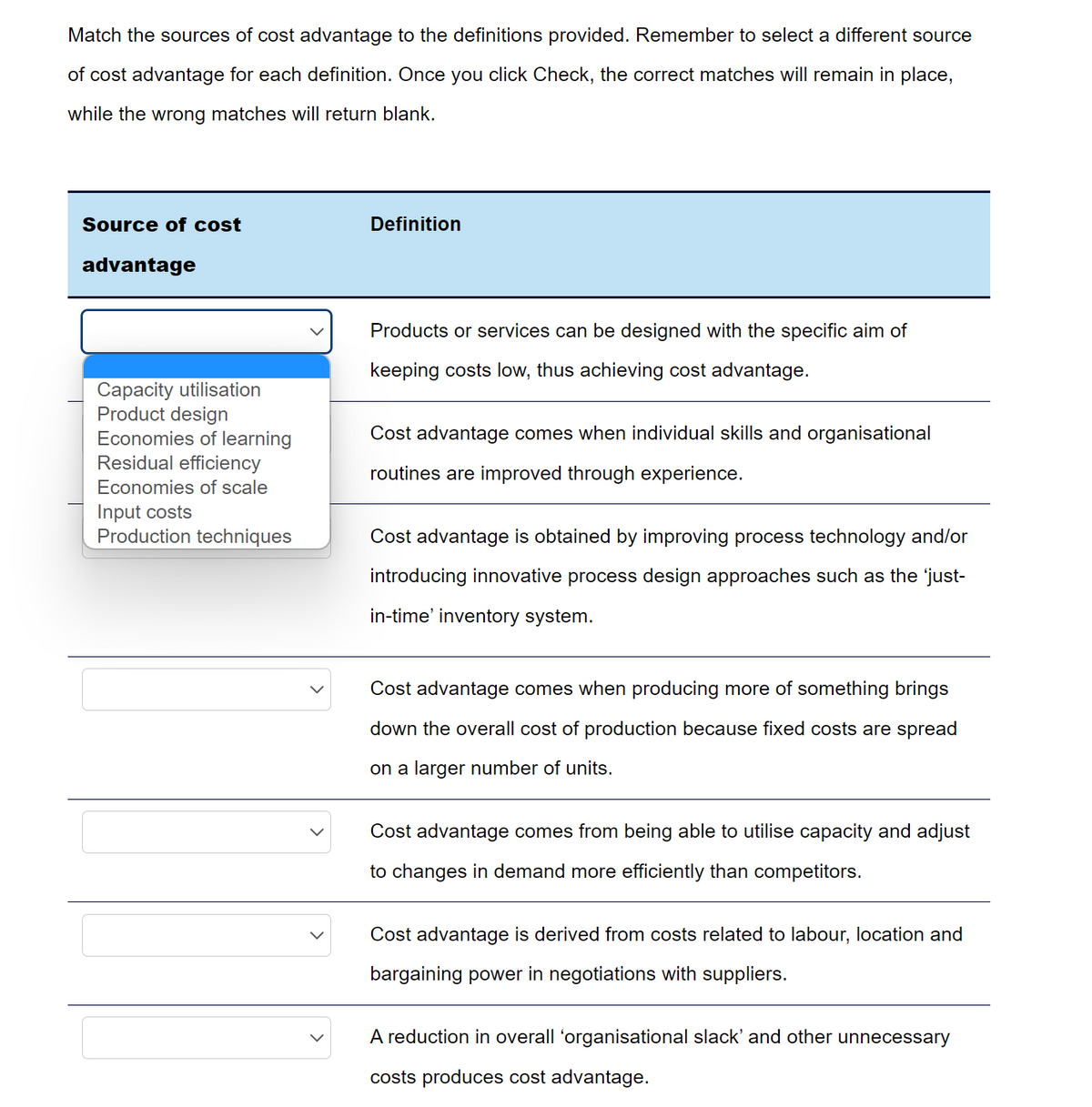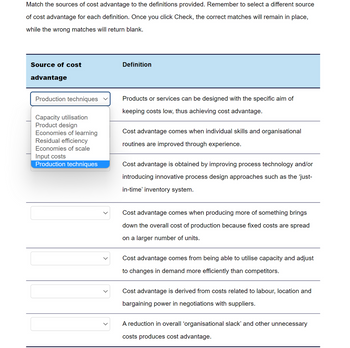Match the sources of cost advantage to the definitions provided. Remember to select a different source of cost advantage for each definition. Once you click Check, the correct matches will remain in place, while the wrong matches will return blank. Source of cost advantage Capacity utilisation Product design Economies of learning Residual efficiency Economies of scale Input costs Production techniques Definition Products or services can be designed with the specific aim of keeping costs low, thus achieving cost advantage. Cost advantage comes when individual skills and organisational routines are improved through experience. Cost advantage is obtained by improving process technology and/or introducing innovative process design approaches such as the 'just- in-time' inventory system. Cost advantage comes when producing more of something brings down the overall cost of production because fixed costs are spread on a larger number of units. Cost advantage comes from being able to utilise capacity and adjust to changes in demand more efficiently than competitors. Cost advantage is derived from costs related to labour, location and bargaining power in negotiations with suppliers. A reduction in overall 'organisational slack' and other unnecessary costs produces cost advantage.
Match the sources of cost advantage to the definitions provided. Remember to select a different source of cost advantage for each definition. Once you click Check, the correct matches will remain in place, while the wrong matches will return blank. Source of cost advantage Capacity utilisation Product design Economies of learning Residual efficiency Economies of scale Input costs Production techniques Definition Products or services can be designed with the specific aim of keeping costs low, thus achieving cost advantage. Cost advantage comes when individual skills and organisational routines are improved through experience. Cost advantage is obtained by improving process technology and/or introducing innovative process design approaches such as the 'just- in-time' inventory system. Cost advantage comes when producing more of something brings down the overall cost of production because fixed costs are spread on a larger number of units. Cost advantage comes from being able to utilise capacity and adjust to changes in demand more efficiently than competitors. Cost advantage is derived from costs related to labour, location and bargaining power in negotiations with suppliers. A reduction in overall 'organisational slack' and other unnecessary costs produces cost advantage.
Practical Management Science
6th Edition
ISBN:9781337406659
Author:WINSTON, Wayne L.
Publisher:WINSTON, Wayne L.
Chapter8: Evolutionary Solver: An Alternative Optimization Procedure
Section8.6: Fitting An S-shaped Curve
Problem 9P
Related questions
Question

Transcribed Image Text:Match the sources of cost advantage to the definitions provided. Remember to select a different source
of cost advantage for each definition. Once you click Check, the correct matches will remain in place,
while the wrong matches will return blank.
Source of cost
advantage
Capacity utilisation
Product design
Economies of learning
Residual efficiency
Economies of scale
Input costs
Production techniques
Definition
Products or services can be designed with the specific aim of
keeping costs low, thus achieving cost advantage.
Cost advantage comes when individual skills and organisational
routines are improved through experience.
Cost advantage is obtained by improving process technology and/or
introducing innovative process design approaches such as the 'just-
in-time' inventory system.
Cost advantage comes when producing more of something brings
down the overall cost of production because fixed costs are spread
on a larger number of units.
Cost advantage comes from being able to utilise capacity and adjust
to changes in demand more efficiently than competitors.
Cost advantage is derived from costs related to labour, location and
bargaining power in negotiations with suppliers.
A reduction in overall 'organisational slack' and other unnecessary
costs produces cost advantage.
Expert Solution
This question has been solved!
Explore an expertly crafted, step-by-step solution for a thorough understanding of key concepts.
Step by step
Solved in 2 steps

Follow-up Questions
Read through expert solutions to related follow-up questions below.
Follow-up Question

Transcribed Image Text:Match the sources of cost advantage to the definitions provided. Remember to select a different source
of cost advantage for each definition. Once you click Check, the correct matches will remain in place,
while the wrong matches will return blank.
Source of cost
advantage
Production techniques
Capacity utilisation
Product design
Economies of learning
Residual efficiency
Economies of scale
Input costs
Production techniques
Definition
Products or services can be designed with the specific aim of
keeping costs low, thus achieving cost advantage.
Cost advantage comes when individual skills and organisational
routines are improved through experience.
Cost advantage is obtained by improving process technology and/or
introducing innovative process design approaches such as the 'just-
in-time' inventory system.
Cost advantage comes when producing more of something brings
down the overall cost of production because fixed costs are spread
on a larger number of units.
Cost advantage comes from being able to utilise capacity and adjust
to changes in demand more efficiently than competitors.
Cost advantage is derived from costs related to labour, location and
bargaining power in negotiations with suppliers.
A reduction in overall 'organisational slack' and other unnecessary
costs produces cost advantage.
Solution
Recommended textbooks for you

Practical Management Science
Operations Management
ISBN:
9781337406659
Author:
WINSTON, Wayne L.
Publisher:
Cengage,

Practical Management Science
Operations Management
ISBN:
9781337406659
Author:
WINSTON, Wayne L.
Publisher:
Cengage,